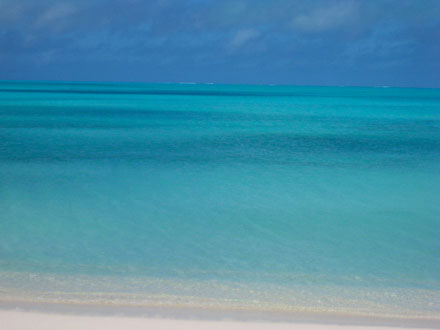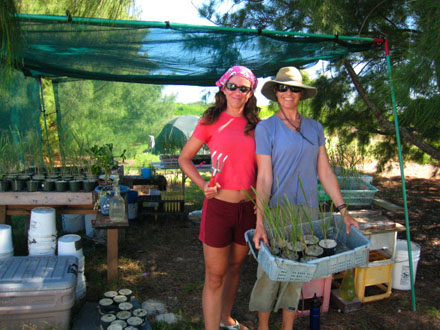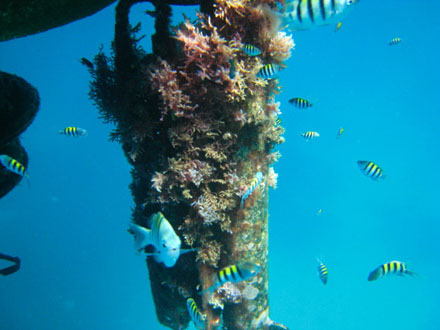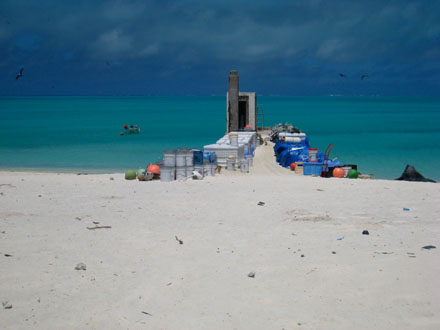|
You
are here: /main/research
expeditions/July 2007/Journal
Day 13
Journal
Day 13 - Kure Atoll
by Keeley Belva
Don’t forget—if you’re in Honolulu, you
can learn more about the Monument at the Outrigger Waikiki
Beach hotel when NWHI researchers “talk story” Saturdays
in July from 9-11am.
Click
here to see where the Hi'ialakai is now.
Click
here to see current data from the ship.
Yesterday, Day 13 of the 25-day cruise, I
had the opportunity to spend part of the day on land at Kure
Atoll State Wildlife Sanctuary. My first impression of the
northern most island in the chain were the amazing colors
of the water and clouds as we crossed the lagoon—it
was like being in a poster! Greeted by the enthusiastic
and dedicated staff that is working on the island this summer,
I was dropped off by the research boat in the morning before
they continued on their way to begin their dives. I
had a few hours to see what kind of work was going on at
the Refuge, and from the list that Sanctuary Field Camp Leader
Cynthia Vanderlip had sent me we had a lot to cover in just
a few hours.

Kure lagoon. Credit: Keeley Belva
One would think that this far away from traffic, shopping
malls, and chain restaurants that signs of human impact would
be hard to find. However that is definitely not the
case—besides the group’s office/kitchen/quarters
(at least for those not sleeping in tents), which is a remnant
from Kure’s U.S. Coast Guard days, there are the ants
that are crawling all over everything, and the plastic pieces
that are scattered around the ground, and the fields of yellow
flowers…verbesina. The verbesina I learn is
one of the biggest problems on the island. It is an
invasive species that is found on a few of the islands in
the NWHI. Pulling these plants is hard work, but restoring
the vegetation to its original state is a larger effort. The
Kure folks have a nursery were they are growing native bunch
grass and naupaka for replanting and to give the albatross
and other sea birds a more suitable nesting habitat.

Kure nursery. Credit: Keeley Belva
Later, as we walked along the beach checking on the population
of Hawaiian monk seals that make Kure their home, you could
see more even evidence of humans. Marine debris that
was strewn along the beach—glass bottles (no messages)
and plastic floats that had originated from all over the
Pacific—was interspersed with albatross tracks and
monk seal haul-out holes. On the pier there were piles
of nets and large debris that the group has collected in
preparation for the next visit from the NOAA marine debris
group that collects the debris from around the NWHI to take
back to Honolulu.

Marine debris on the beach at Kure Atoll. Credit:
Keeley Belva
While it is somewhat discouraging to see that humans have
such a far-reaching effect on this distant archipelago, but
I’m encouraged by the efforts that are taking place
to care for this special place. It is also a lesson
in how we all contribute to the beauty and pristine state
of these islands. Mahalo nui loa to Cynthia and her
team for their hospitality!

Mini-reef community on the bottom of a buoy in Kure
Lagoon. Credit: Keeley Belva
 Marine
debris on the pier of Kure Atoll. Credit:
Keeley Belva Marine
debris on the pier of Kure Atoll. Credit:
Keeley Belva
Don’t
forget—if you’re in Honolulu, you can learn more
about the Monument at the Outrigger Waikiki Beach hotel when
NWHI researchers “talk story” Saturdays in July
from 9-11am.
Click
here for maps of the region
|